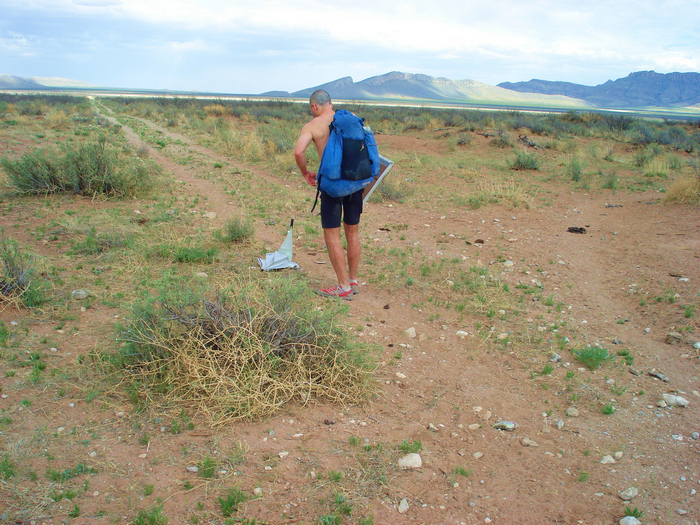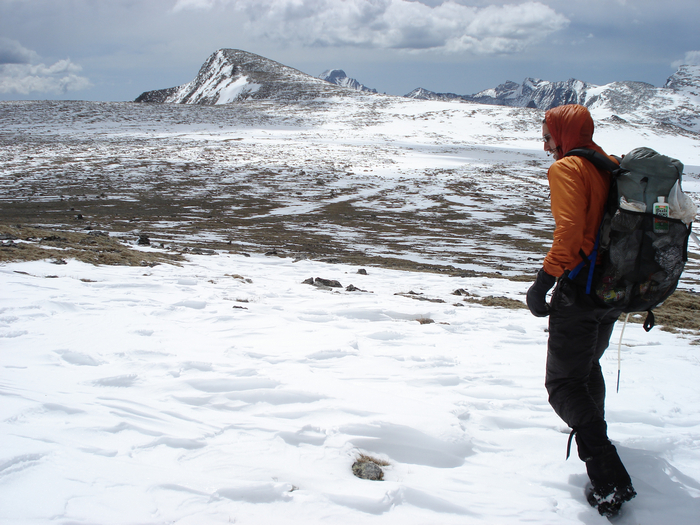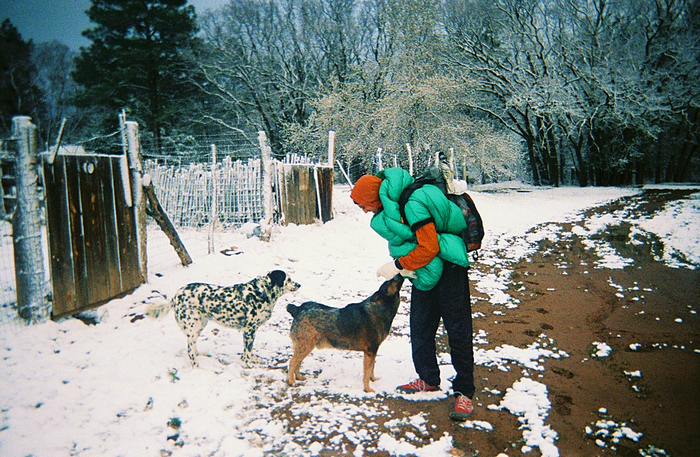Imagine kissing your job and your friends goodbye to thru-hike a long trail over six months, then quitting the trail in just a couple of days. As loony as that sounds, it is what happens to hundreds of people every season as they are surprised by the reality of a thru-hike. About one in five prospective Appalachian Trail thru-hikers quit within the first week!
What's even more surprising is that most of those who quit don't do it because they suffer an injury. In fact, most who quit have no ailments and they adore backpacking. Their love for the outdoors is what motivated them to thru-hike a trail in the first place. They love backpacking and figure a thru-hike is a natural extension of that love.
Such reasoning is flawed, because backpacking and thru-hiking are different species.
People don't discover this pre-thru-hike because they simply rely on their limited backpacking experience, their gut instinct, or Uncle Harry who supposedly knows everything. This article is for people who are considering thru-hiking a long trail and want to make sure they know what they're getting into.
Gear Selection
Everyone who attempts to thru-hike a trail that's over 2,000 miles long learns that there is a big difference between backpacking and thru-hiking. For example, compared to a successful thru-hiker, the typical backpacker brings far more and far heavier items:
|
A Typical Backpacker Brings |
A Typical Thru-Hiker Brings |
|
Multiple pots and pans to make gourmet meals |
One ultralight titanium pot |
|
Fresh clothes for each day outside |
Extra pair of underwear - no extra clothes |
|
Large, comfortable tent |
Tarp |
|
Full-length deluxe inflatable mattress |
Thin foam pad |
|
Heavy-duty sleeping bag |
Light sleeping bag (sleep with your clothes if it's cold) |
|
Gigantic expedition backpack |
Small, lightweight backpack
|
|
Camp shoes and lightweight chair |
Neither
|
|
An MP3 player |
Ears to listen to nature
|
Bringing a sleeping bag that is one pound lighter than a typical sleeping bag may not seem like much, but the differences begin to add up. Even little items, such as a minuscule knife versus a full-size Swiss army knife, can have an impact if you do it across the board.
Indeed, if you consistently pack an item that weighs 25 to 50 percent less than the typical version of that item, your pack weight will decline 25 to 50 percent. As obvious as that sounds, most of those who plan a thru-hike don't think about this, nor do they heed the lesson of those who have hiked before them. Instead, hikers look at their heavy-duty compass and think, "What's the big deal? It's only an ounce or two heavier."
On the other hand, a prepared thru-hiker will search for a lightweight, accurate compass. In my case, for example, my compass is integrated in my watch. In fact, the Appalachian Trail is so well marked that you could even leave your compass at home. I learned that carrying a compass does not guarantee that you will not get lost - I managed to get lost on the Appalachian Trail even with signs all around me.
The Backpacking Paradox
 The paradox of backpacking is that the more distance you walk, the less you should carry.
The paradox of backpacking is that the more distance you walk, the less you should carry.
This is counter-intuitive, and the best way to learn the lesson is through the experiences of others, though statistics prove that many learn in a more expensive and frustrating way: through their own experience.
A smart thru-hiker carries the bare minimum to be safe and walks 10 to 30 miles a day so that he avoids backpacking in the winter (which requires far more gear and is more dangerous than hiking during the other three seasons).
If a thru-hiker desires additional comfort, she can usually buy it or have it shipped to her next resupply point, which is rarely more than four days away. Such a lightweight strategy lets her minimize both body stress and calorie burn.
The weekend backpacker, on the other hand, is often in no rush, so he can afford to carry the kitchen sink because he's usually not walking very far.
The casual backpacker loves having the pancake griddle and the comfy chair in the middle of nowhere. He walks five miles, sets up camp, and enjoys relaxing with his espresso. Although that is great fun, it can cloud your ability to understand the backpacking paradox that one should carry less the more one travels.
Learning from Trail Lore
 Hundreds of people have completed the Appalachian Trail and several people have written books about what you should bring and how to minimize your pack's weight. Nevertheless, every season, over half of the hikers ignore trail lore and repeat the same errors as the previous year's hikers.
Hundreds of people have completed the Appalachian Trail and several people have written books about what you should bring and how to minimize your pack's weight. Nevertheless, every season, over half of the hikers ignore trail lore and repeat the same errors as the previous year's hikers.
Visit either terminus on the Appalachian Trail and you'll find people starting their thru-hike with gigantic 50-pound packs. By the end of the journey, nearly everyone will have trimmed down their packs to half their starting size.
To do this, thru-hikers frequently abandon hundreds of dollars of gear, buy hundreds of dollars of new gear, and get back on the trail again. The abandoned gear in hiker boxes testifies to the expensive lesson of what separates thru-hiking and backpacking.
At least a few people benefit: one thru-hiker I met was able to hike from Georgia to New York on $20. He didn't start with any gear, but he picked up most of what he used from the castoffs of hikers before him.
He acquired almost all the gear he needed in just the first 30 miles! He also lived off the food that hikers didn't want because they learned that eating the same food every day gets a bit old after a while.
History not used is nothing... and if you don't use the stuff - well, it might as well be dead. - Arnold Toynbee
It's important to learn from history. Before you thru-hike, talk to those who've gone before you. One guy told me about hiking 10 miles a day and carrying 70 pounds - this same guy would later tell me about his chronic back problems.
Many outdoor shop salesmen (who often know little about thru-hiking) encourage beginning thru-hikers to get an "expedition" backpack, even though most thru-hikers would be better off with the "day packs."
Getting a small backpack is a great way to discipline yourself. With so little storage space, you have no other choice but to get rid of unnecessary items and to find lighter versions of the necessary ones.
When I talked with the thru-hikers, they all wished that they had minimized their pack weight from the start. In other words, they all wished that they had learned from trail lore. This lesson applies to life off the trail too. The goal is to learn from other people's experiences so that your experience is the best it can be.
Fortunately, most of the readers here already practice the concept of lightweight backpacking. Nevertheless, they undergo their own transformation during a thru-hike, and they should anticipate and prepare for it accordingly. What often happens is that they go from being lightweight backpackers to ultralight backpackers. Help avoid the transition in the middle of the thru-hike and make sure you have truly pared down your gear list.
Physical and Mental Preparation
Typical backpackers can be out of shape and don't need much mental fortitude. If it's pouring rain, a backpacker can just postpone the trip or stay in camp for the day. A thru-hiker has no such luxury and must press on. This ability to wake up early and break down a campsite during a rainstorm is uncommon in backpackers but common with thru-hikers.
The related difference is physical conditioning. Many thru-hikers start out of shape. That's OK, but to increase your odds of successfully finishing a thru-hike, get in shape. Doing so will result in a crucial side-benefit: you'll develop your mental toughness.
For instance, before doing my first thru-hike (the Appalachian Trail), I would take a vacation day on a three-day holiday to make a four-day weekend. Do the same and try to hike at least 15 miles each day. Get up the next day and do it again. And again.
If you can do that, then pick a weekend that has a weather forecast of challenging weather. Doing back-to-back 20 miles days under nonstop rain is different than doing it in ideal weather.
After a couple of long weekends of doing that, you'll have a good idea if you have the physical and mental fortitude required of finishing a thru-hike. More importantly, pay attention if you are truly enjoying the experience. Surviving isn't enough - the goal is to survive with a smile.
Food Selection
 Another example of the difference between backpacking and thru-hiking is food selection. Backpackers often buy expensive packaged freeze-dried meals. Or, they tend to favor gourmet meals and attempt to reproduce Wolfgang Puck's cooking in the woods.
Another example of the difference between backpacking and thru-hiking is food selection. Backpackers often buy expensive packaged freeze-dried meals. Or, they tend to favor gourmet meals and attempt to reproduce Wolfgang Puck's cooking in the woods.
Thru-hikers have a far different diet. First, all but the wealthiest thru-hikers avoid expensive freeze-dried meals because they will break their budget over six months.
Second, a thru-hiker's cooking habits are more about efficiency than about being a five-star chef. That means simple meals that can be made in one pot. Boiling water is about as complicated as it gets.
Third, thru-hikers have paradoxical dietary requirements.
On the one hand, they need healthy, nutritious food to power their body for months and help with recuperating after each hard-working day.
Without such healthy nutrition, many bodies (especially older ones) will have trouble somewhere along the way.
On the other hand, thru-hikers have a peculiar (and seemingly insatiable) need for junk food. Chocolate bars are a thru-hiker's currency.
Therefore, beginning thru-hikers often need to simplify their cooking gear and food preparation habits. They can't afford to ignore their long-term nutritious dietary needs. And yet, they need to consider the psychological benefits of tossing in a bone (or in this case, a sweet treat) into their supplies to keep morale and motivation up.
Conclusion
Every thru-hiker loves backpacking, but most backpackers wouldn't like thru-hiking. Thru-hiking is not simply "lots of backpacking." It's a different sport altogether. Traditional backpacking has a pattern of hike-rest-hike-rest. Thru-hiking's pattern is hike-hike-hike-rest-hike-hike-hike.
For many, the monotony and rigor of thru-hiking can turn backpacking into a job and not just a simple walk in the woods. That explains why a whopping 50 percent quit within the first six weeks of a thru-hike that normally takes six months. Get prepared by trimming your gear, learning from trail lore, picking smart foods, and exercising your body and mind.
This article was adapted from Hike Your Own Hike: 7 Life Lessons from Backpacking Across America. This article was first published online at: "Backpacking versus Thru-hiking," by Francis Tapon. BackpackingLight.com (ISSN 1537-0364).
http://backpackinglight.com/cgi-bin/backpackinglight/backpacking_v_thruhiking.html, 2011-09-20 00:00:00-06.




